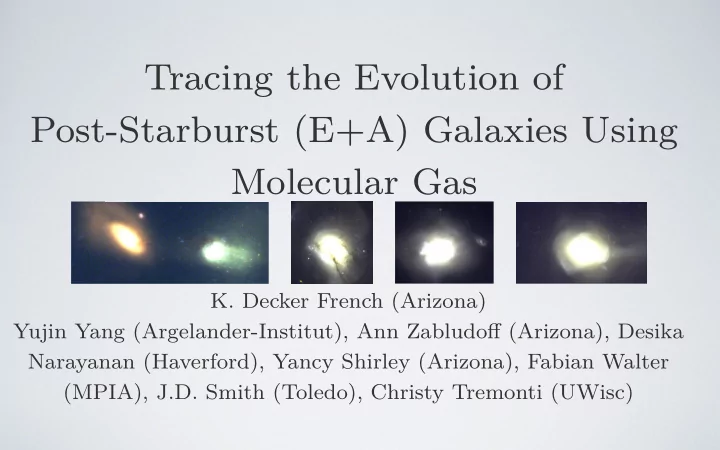

Tracing the Evolution of Post-Starburst (E+A) Galaxies Using Molecular Gas K. Decker French (Arizona) Yujin Yang (Argelander-Institut), Ann Zabludo ff (Arizona), Desika Narayanan (Haverford), Yancy Shirley (Arizona), Fabian Walter (MPIA), J.D. Smith (Toledo), Christy Tremonti (UWisc)
Why Post-Starburst Galaxies?
Why Post-Starburst Galaxies? Weak H alpha Emission Strong Balmer What happened Absorption here?
Detection of Molecular Gas • 32 galaxies with IRAM 30m in CO (1-0) and CO (2-1) • 13 galaxies with SMT 10m in CO (2-1)
Detection of Molecular Gas • 32 galaxies with IRAM 30m in CO (1-0) and CO (2-1) • 13 galaxies with SMT 10m in CO (2-1) • Detect 17/32 galaxies in CO (1-0)
Molecular gas masses comparable with star-forming galaxies Young+ 2011, Saintonge+ 2011 f(gas)= M(H2)/M ★
Many post-starbursts are LINERs! Complicates star- formation rate
Star-Formation-Rate vs. M(H2) Upper limits Upper limits Gao&Solomon (2004), Saintonge+ (2011), Crocker+ (2011)
Molecular gas vs. star-formation rate surface densities Upper limits Upper limits Kennicutt-Schmidt plot (Kennicutt 1998)
Why are post-starbursts o ff set? • CO-to-H2 conversion factor α CO • ULIRG type value can provide consistency, but: t(post-burst) > t(dyn) • Stellar component not enough to lower α CO
Why are post-starbursts o ff set? • CO-to-H2 conversion factor α CO • ULIRG type value can provide consistency, but: t(post-burst) > t(dyn) • Stellar component not enough to lower α CO • Distribution? • Some evidence from CO (2-1) comparison that CO is not extended enough to resolve o ff set • But, distribution of SF regions largely unconstrained
Why are post-starbursts o ff set? • CO-to-H2 conversion factor α CO • ULIRG type value can provide consistency, but: t(post-burst) > t(dyn) • Stellar component not enough to lower α CO • Distribution? • Some evidence from CO (2-1) comparison that CO is not extended enough to resolve o ff set • But, distribution of SF regions largely unconstrained • Lowered star-formation e ffi ciency? Bottom-heavy initial mass function?
What caused the sudden end to star formation? • Gas used up? • Gas ejected or removed from galaxy? • Gas dispersed within galaxy? • Starvation? • Gas heated? • Morphological quenching? Other?
What caused the sudden end to star formation? • Gas used up? → No, large molecular gas reservoirs • Gas ejected or removed from galaxy? → No, large molecular gas reservoirs • Gas dispersed within galaxy? → KS o ff set observed, need spatial info → No, large molecular gas reservoirs • Starvation? • Gas heated? ? Something else must happen to the gas • Morphological quenching? Other? ?
Next Steps • Denser gas tracers Something else must happen to the gas • HCN • Resolved CO emission • H alpha mapping to observe current SF KS o ff set observed, need spatial info • ALMA, as well as current optical/ IFU facilities will help understand the state of the molecular gas and current activity in this critical period in galaxy evolution
Conclusions • Post-Starburst galaxies, in transition between star-forming and early type • Molecular gas detected in ~half • M(H2) 10 8.6 -10 9.8 Msol -- comparable to star-forming galaxies • Gas fractions 10 -2 - 10 -0.5 -- comparable to star-forming galaxies • Star formation rates ~10x lower • Post-starbursts fall low on molecular gas - star formation rate surface density relation • Rule out complete gas consumption/expulsion/starvation as end of starburst in this sample
Recommend
More recommend